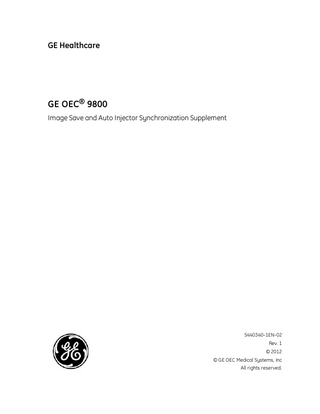GE Healthcare
OEC 9800 Image Save and Auto Injector Synchronization Supplement Rev 1 Dec 2012
Supplement
6 Pages

Preview
Page 1
GE Healthcare
GE OEC® 9800 Image Save and Auto Injector Synchronization Supplement
5440340-1EN-02 Rev. 1 © 2012 © GE OEC Medical Systems, Inc All rights reserved.
GE OEC 9800 Image Save and Auto Injector Synchronization Supplement
Revision history Rev #
Date
Description of changes
1
12-2012
Production Release
EN
This update contains product information for the GE OEC 9800. It is to be used in conjunction with your system’s Operator’s Manuals.
GE OEC Medical Systems, a General Electric company, going to market as GE Healthcare.
GE OEC Medical Systems, Inc. 384 Wright Brothers Drive Salt Lake City, Utah 84116 U.S.A. 801-328-9300
ii
GE OEC 9800 / 9900 Entrance Dose
Table of Contents Revision history 9800 Supplement 1.1 Saving Images 1.2 Auto Inject Synchronization
ii 1 1 2
iii
GE OEC 9800 / 9900 Entrance Dose This page intentionally left blank.
iv
GE OEC 9800 Image Save and Auto Injector Synchronization Supplement
9800 Supplement 1.1 Saving Images A Save icon displays in the bottom left corner of the left monitor when images are saved.
To ensure that images are saved properly, wait until the SAVE icon disappears before performing any other function (such as swap, recall, reverse, and so on). To shut the system down after pressing Save, follow the shutdown procedure in the 9800 Operator Manual Update and Supplement.
Images not saved When saving images, the system makes the audible tone and displays the Save icon on the left monitor to indicate that the image is being saved. NOTE: Systems with software version 29 and earlier do not display this icon, but the tone still sounds. Press Help to display the software versions screen. If the system fails to save images, shut down the system and call GE OEC service.
Swap key operation Press the Swap key to exchange images between the left and right monitor. When an image is displayed on the left monitor and no image or a temporary image is displayed on the right monitor, pressing the Swap key displays the left monitor image on the right monitor. NOTE: The Swap key causes the image on the left monitor to be displayed on the right monitor after system startup, at the beginning of a new exam, and at the end of a subtraction or Roadmap image acquisition. NOTE: Pressing the Swap key replaces the temporary image on the right monitor with the image on the left monitor. NOTE: To ensure images are saved properly, the Swap key should not be pressed while the Save icon is displayed.
1
GE OEC 9800 Image Save and Auto Injector Synchronization Supplement
1.2 Auto Inject Synchronization When properly set up and connected, an automated injector injects a preset amount of contrast media upon receiving a signal from the Workstation. During digital subtraction, the inject signal is sent when the syringe icon is displayed on the left monitor. Display of the syringe icon indicates that a digital mask has been acquired and the injection of contrast media may begin. Make sure the injector is set up to respond to the external signal from the Workstation. If the injector is not properly set up, contrast media may be injected prematurely or not at all. Table 1-1 details the Workstation modes when the signal is sent from the Workstation to the injector. NOTE: An automated injector must be correctly connected to the Workstation and armed before the Workstation can automatically activate the injector and inject contrast media. Table 1-1: Workstation auto inject synchronization. Mode
Cue
Contrast Injected
Subtraction
Inject icon displayed. Status bar =
Inject signal is sent when icon is displayed.
Roadmap-1
Inject icon displayed. Status bar =
Inject icon is displayed while Roadmap-1 is active. The Workstation does not send a signal to the injector. The injector must be triggered manually.
HLF with Cine Status bar =
Inject signal is sent as soon as the image is stable, 1 to 2 seconds after the X-ray switch is pressed.
Digital Cine
Status bar =
Inject signal is sent as soon as the image is stable, 1 to 2 seconds after the X-ray switch is pressed.
Digital Cine Pulse
Pressing the cardiac pedal.
Inject signal is sent as soon as the image is stable, 1 to 2 seconds after the X-ray switch is pressed.
2